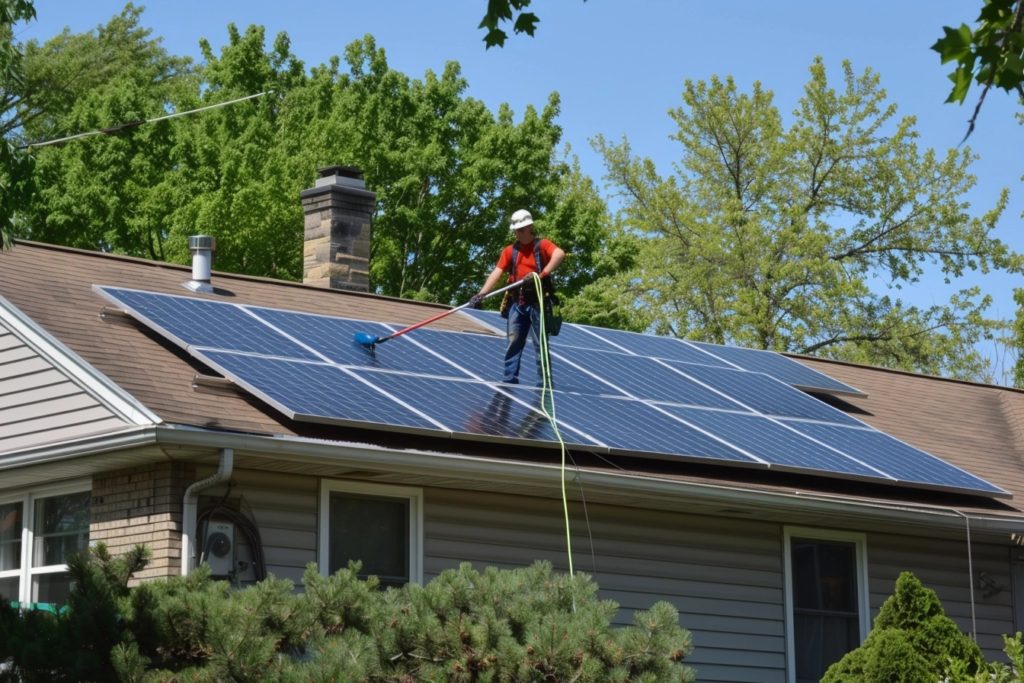10 reasons we’ve heard customers say they love solar.
10. Community Impact
Going solar can inspire others in the community to consider renewable energy options. It fosters a culture of sustainability and environmental responsibility, creating a positive ripple effect.
9. Energy Security
Solar energy can contribute to a more secure energy future. By diversifying our energy sources and reducing reliance on imported fuels, solar power enhances national energy security.
8. Job Creation
The solar industry is a significant source of job creation. By going solar, individuals support an industry that provides employment opportunities in manufacturing, installation, and maintenance.
7. Low Maintenance
Solar panels require minimal maintenance. With no moving parts, they are durable and can last a long time with little upkeep, providing a hassle-free energy solution.
6. Technological Advancements
Advancements in solar technology have made panels more efficient and affordable than ever before. Innovations continue to improve the performance and aesthetics of solar systems, making them an attractive option for more homeowners.
5. Possible Government Incentives
Many governments offer incentives, such as tax credits and rebates, to encourage the adoption of solar energy. These financial incentives can significantly offset the initial cost of installing solar panels.
4. Potential for Increased Property Value
Homes equipped with solar panels can often see an increase in property value. Potential buyers are attracted to the prospect of lower energy bills and the eco-friendly benefits of solar energy.
3. Energy Independence
With solar panels, homeowners can produce their own electricity, reducing their dependence on the grid. This independence can be particularly valuable during power outages or in remote areas where grid access is limited if they have batteries as well.
2. Environmental Impact
Solar energy is a clean, renewable resource that reduces our reliance on fossil fuels. By going solar, individuals can significantly lower their carbon footprint and contribute to a healthier planet.
1. Savings on Energy Bills
One of the most compelling reasons people switch to solar energy is the potential for savings on their electricity bills. By generating their own power, homeowners can often reduce their monthly energy costs.
Switching to solar energy offers a multitude of benefits, from financial savings to environmental stewardship. It’s no wonder more and more people are making the switch and loving the results!
What do you think? Are you considering going solar too? 🌞
Investing in residential solar panels is an excellent way to reduce your carbon footprint and save on electricity costs. However, the amount of money you can save depends significantly on the number of sun hours your location receives. This blog post will explore how sun hours affect your solar savings and what factors you should consider when evaluating the potential benefits of residential solar.
Understanding Sun Hours
Sun hours, also known as peak sun hours, refer to the amount of sunlight a location receives in a day, measured in hours of maximum solar radiation. One peak sun hour is equivalent to 1,000 watts of solar energy per square meter of solar panel per hour. This metric is crucial because it directly impacts the amount of electricity your solar panels can generate.
Geographic Location
Your geographic location is the primary determinant of the number of sun hours you receive. Areas closer to the equator typically enjoy more consistent and intense sunlight throughout the year, leading to higher solar energy production. For example, southern states in the U.S., such as Arizona and California, receive more sun hours compared to northern states like Washington or New York.
Seasonal Variations
Sun hours can also vary with the seasons. In many regions, the summer months bring longer days and more intense sunlight, leading to higher solar energy production. Conversely, winter months have shorter days and less sunlight, which can reduce the efficiency of your solar panels. Understanding these seasonal variations can help you estimate the annual solar output and potential savings.
Solar Panel Orientation and Tilt
The orientation and tilt of your solar panels can significantly impact the number of effective sun hours they receive. Ideally, solar panels should be installed facing true south in the northern hemisphere (or true north in the southern hemisphere) to maximize sun exposure. The tilt angle should be adjusted according to your latitude to capture the maximum amount of sunlight throughout the year.
Local Climate and Weather Patterns
Local climate and weather patterns also play a crucial role in determining sun hours. Areas with frequent cloudy or rainy days will have reduced sun hours compared to regions with clear, sunny skies. While occasional clouds won’t drastically affect your solar savings, consistently overcast conditions can lead to lower energy production and savings.
Shading and Obstructions
Shading from trees, buildings, or other obstructions can significantly reduce the number of sun hours your solar panels receive. Even partial shading can cause a disproportionate drop in solar panel efficiency. Conducting a thorough shading analysis before installation can help you identify and mitigate potential shading issues to maximize your sun hours and savings.
Calculating Solar Savings
To estimate your solar savings, you need to consider the average number of peak sun hours your location receives and the efficiency of your solar panels. Most solar panels have an efficiency rating that indicates the percentage of sunlight they can convert into electricity. By multiplying the average daily sun hours by the total capacity of your solar system and its efficiency, you can estimate the amount of electricity your system will generate.
For example, if you live in an area that receives an average of 5 peak sun hours per day, and you have a 5 kW solar system with an efficiency of 20%, your daily electricity generation would be:
5 hours/day × 5kW × 0.20 = 5kWh/day
5 hours/day×5 kW×0.20=5 kWh/day
By comparing this figure to your daily electricity consumption, you can estimate your potential savings.
Maximizing Your Solar Savings
To maximize your solar savings, consider the following tips:
- Optimal Installation: Ensure your solar panels are installed at the best orientation and tilt for your location.
- Regular Maintenance: Keep your solar panels clean and free from debris to maintain their efficiency.
- Monitor Shading: Regularly check for new shading from growing trees or new constructions and address any issues promptly.
- Energy Efficiency: Complement your solar system with energy-efficient appliances and habits to reduce overall consumption.
Conclusion
Sun hours play a pivotal role in determining the effectiveness and savings of residential solar systems. By understanding and optimizing factors such as geographic location, seasonal variations, panel orientation, and local climate, you can maximize your solar energy production and achieve significant cost savings. Investing in residential solar is not just about harnessing the power of the sun; it’s about making smart choices to ensure you get the most out of your solar investment.
Embrace the power of solar energy and start your journey toward sustainable living and financial savings today!
As energy costs continue to rise, finding effective ways to reduce your energy bill becomes increasingly important. At LGCY Power, we understand the value of conserving energy and saving money. Here’s our countdown our 10 favorite ways to save on your energy bill, culminating in the ultimate energy-saving solution.
10. Switch to LED Lighting
Swapping out traditional incandescent bulbs for LED lighting is a simple yet impactful change. LED bulbs use up to 80% less energy and last significantly longer, reducing both your energy consumption and replacement costs.
Does Unplugging Electronics Save on Electricity?
9. Use Smart Power Strips
Many electronics continue to draw power even when turned off. Smart power strips cut off the electricity supply to devices that are in standby mode, effectively eliminating “phantom” energy use and saving you money over time.
What runs your electricity bill up the most?
8. Install a Programmable Thermostat
Heating and cooling account for nearly half of the average household’s energy bill. A programmable thermostat allows you to set specific temperatures for different times of the day, ensuring that you’re not wasting energy when you’re not home or while you sleep.
7. Optimize Your Water Heater
Lowering the temperature on your water heater to 120 degrees Fahrenheit can save energy and reduce costs. Additionally, insulating your water heater and the first six feet of hot and cold water pipes can improve efficiency.
6. Seal and Insulate Your Home
Proper insulation and sealing of gaps and cracks in your home prevent heat from escaping in the winter and cool air from leaking out in the summer. This reduces the workload on your heating and cooling systems, resulting in lower energy consumption.
5. Use Energy-Efficient Appliances
When it’s time to replace old appliances, choose those with the Energy Star label. These appliances meet strict efficiency guidelines and can use up to 50% less energy than their non-efficient counterparts.
4. Maximize Natural Light
Take advantage of natural light by keeping blinds and curtains open during the day. This reduces the need for artificial lighting and can help to heat your home in the winter, lowering both lighting and heating costs.
3. Perform Regular HVAC Maintenance
Regular maintenance of your heating, ventilation, and air conditioning (HVAC) system ensures it runs efficiently. Clean filters, unobstructed vents, and professional tune-ups prevent your system from working harder than necessary, saving energy and extending its lifespan.
2. Use Ceiling Fans Wisely
Ceiling fans can help circulate air and reduce the need for heating and cooling. In the summer, set fans to spin counterclockwise to create a cooling breeze. In the winter, set them to spin clockwise at a low speed to push warm air down from the ceiling.
1. Invest in Solar Energy
And our favorite way to save money on your energy bill is through solar energy. Solar panels harness the power of the sun to generate electricity, significantly reducing or possibly eliminating your reliance on traditional power sources. With solar energy, you can lock in lower energy costs, potentially increase your property value, and contribute to a more sustainable future.
What’s the Most Efficient Way to Save on Electricity?
By implementing these energy-saving strategies, you can reduce your energy consumption, lower your bills, and make a positive impact on the environment. From simple changes like switching to LED bulbs to transformative solutions like installing solar panels, each step you take contributes to greater savings and a more energy-efficient home. At [Solar Company Name], we’re here to help you achieve your energy-saving goals. Contact us today to learn more about how solar energy can benefit you.
Bachman Lake Trail
Located near Love Field Airport, this 3.5-mile loop around Bachman Lake is popular for short commutes and offers scenic views of the lake and downtown Dallas.
Santa Fe Trail
A 4.3-mile trail connecting Deep Ellum to White Rock Lake, ideal for those commuting from East Dallas to the downtown area. It’s a straight path with plenty of greenery.
Northaven Trail
This 8.5-mile trail runs east to west through North Dallas, providing a direct route for commuters. It’s well-maintained and has several access points.
Katy Trail
One of the most famous trails, it’s a 3.5-mile path that runs from Victory Park to Highland Park. Perfect for downtown commuters and well-lit for evening rides.
White Rock Creek Trail
Spanning 7.8 miles, this trail connects White Rock Lake to the LBJ Freeway, making it a key route for north-south commutes. It’s surrounded by natural scenery.
SoPac Trail
A newer addition, this 5.5-mile trail connects Uptown to the Lake Highlands area, providing a smooth, uninterrupted ride for commuters.
Campion Trail
Located in Irving, this 13-mile trail follows the Elm Fork of the Trinity River and connects to other major trails, making it a great route for long-distance commuters.
Preston Ridge Trail
A 6.3-mile trail running through North Dallas, connecting parks and neighborhoods. It’s a straight, convenient path for commuting.
Trinity Strand Trail
This 2.5-mile trail connects the Design District to the Katy Trail, offering a unique route through the heart of the city’s creative hub.
White Rock Lake Trail
A 9.3-mile loop around White Rock Lake, this trail is a favorite for both recreation and commuting. It offers stunning lake views and connects to several other major trails.
Investing in a residential solar power system for your home not only helps you save on electricity costs, but also gives you access to a host of government incentives.
Today, we’ll take a look at the top solar incentives in the US that you can take advantage of when you decide to go solar.
#1: Solar Investment Tax Credit
If you have your solar power system installed—or use it for the first time—between January 1, 2006 and December 31, 2023, you are entitled to tax credits you can use to reduce the total amount of income tax you have to pay.
If the installation is done between 2020 and 2022, you’ll receive a 26% tax credit. If it’s done in 2023, you’ll get 22%.
You qualify for this incentive as long as you own the solar power system and have it installed on your primary or secondary home or at an off-site community solar project.
#2: Solar Renewable Energy Certificate
Also known as solar renewable energy credits, solar renewable energy certificates (SREC) are an incentive the state provides to households based on the power their solar power systems generate.
What’s great about these certificates is that you can sell them to energy providers or anyone who’s willing to buy one in exchange for payment that’s generally regarded as taxable income.
To qualify, all you have to do is register your solar power system with the proper state authorities so they can track its energy production.
#3: Tax Exemptions
Depending on where you live, installing a residential solar power system may give you access to certain tax exemptions.
You see, solar power system installations typically cause property values to rise, which, in turn, causes property taxes to also rise—at least that is what’s supposed to happen.
The good news is some states and municipalities don’t take this increase in value into account when calculating property taxes so you don’t have to pay extra just because you want to cut your energy costs.
#4: Subsidized Loans
Depending on the size of your property and your energy requirements, having a solar power system installed may mean a sizable upfront investment. Fortunately, to encourage more households to make the switch to renewable forms of energy, some states offer subsidized loans to make the process easier on the budget.
What does all this mean?
The US government clearly wants more households to transition to renewable forms of energy, such as solar, by offering those that do a host of financial incentives. If you want to take advantage of this opportunity, you need to make the investment now.
Don’t know where to start? Just book a no-obligation free consultation with one of our solar panel consultants and we’ll guide you every step of the way.









